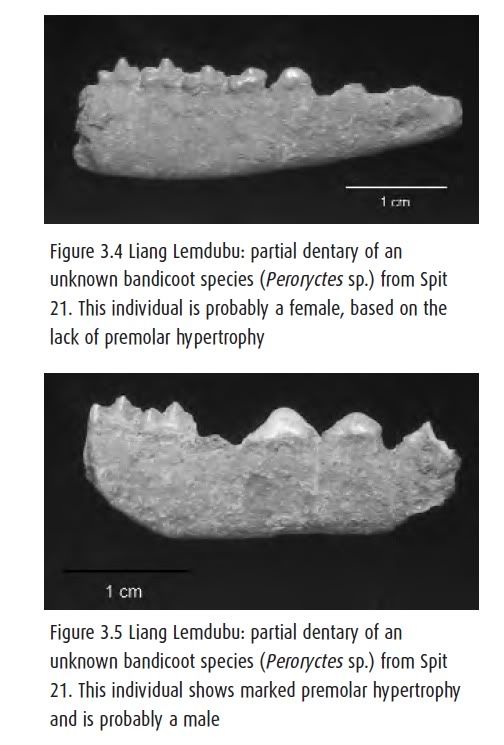Peroryctes sp. Apreviously unknown peroryctid
The most remarkable element of the Aru archaeological fauna is a previously unknown
peroryctid bandicoot species (Figs 3.4 and 3.5). The preserved material of this taxon includes several relatively complete dentaries with all
postcanine teeth intact (eg Figure 3.4) and two
partial maxillae, one with P3–M4 in a moderate
state of wear, and the other with P3–M4 in a
virtually unworn condition. Additionally,
through a process of elimination of I. macrourus
and Echymipera spp., it has been possible to
allocate isolated petrosal elements and calcanea
to this taxon. The cranio-dental and postcranial
material suggests an animal with a body size
somewhat exceeding that of E. rufescens. The
sample of dentaries shows a strongly bimodal
variability in premolar size relative to the molar
teeth; this is interpreted as a manifestation of
sexual dimorphism in the taxon.
The fossil taxon is most similar in dental
morphology to species of Peroryctes but shows
unusual features of upper molar morphology
that preclude referral to this or any other
previously recorded genus of bandicoot. It
further differs from the altitudinally widespread
P. raffrayana (Milne-Edwards, 1878) in
its extreme premolar hypertrophy of putative
male specimens. Sexual dimorphism in premolar
size does occur in several species of
peroryctid bandicoots, most notably Peroryctes
broadbenti (Ramsay, 1879) of southeastern
Papua New Guinea and Echymipera clara Stein, 1932 of the northern lowlands, but these taxa differ
in other important respects from the fossil taxon.
The unknown taxon is moderately abundant in the Liang Lemdubu fauna, being second
only to Isoodon macrourus in number of referred specimens. It is consistently present through the
Liang Lemdubu sequence, with examples in all spits between 25 and 18, and isolated specimens in
higher levels (Spits 14 and 6). All of the bandicoot material is more fragmented in Nabulei Lisa;
however, dentary fragments and pedal elements in Spits 40 to 33 are referred to the new taxon with
a high level of confidence.
 epress.anu.edu.au/terra_australis/ta22/pdf/ch03.pdf
epress.anu.edu.au/terra_australis/ta22/pdf/ch03.pdf